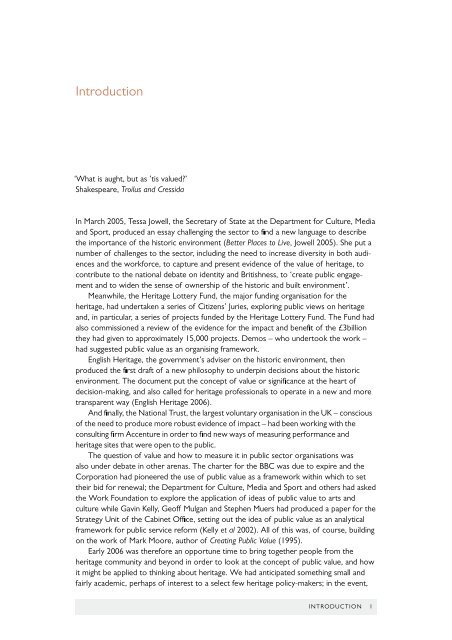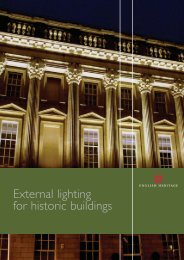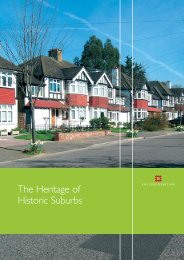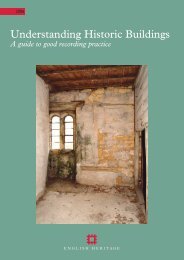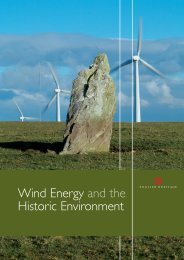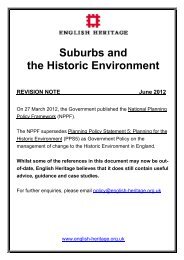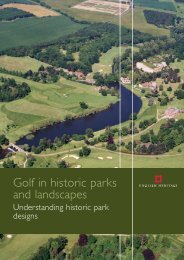Capturing the Public Value of Heritage - HELM
Capturing the Public Value of Heritage - HELM
Capturing the Public Value of Heritage - HELM
Create successful ePaper yourself
Turn your PDF publications into a flip-book with our unique Google optimized e-Paper software.
Introduction<br />
‘What is aught, but as ’tis valued?’<br />
Shakespeare, Troilus and Cressida<br />
In March 2005, Tessa Jowell, <strong>the</strong> Secretary <strong>of</strong> State at <strong>the</strong> Department for Culture, Media<br />
and Sport, produced an essay challenging <strong>the</strong> sector to find a new language to describe<br />
<strong>the</strong> importance <strong>of</strong> <strong>the</strong> historic environment (Better Places to Live, Jowell 2005). She put a<br />
number <strong>of</strong> challenges to <strong>the</strong> sector, including <strong>the</strong> need to increase diversity in both audiences<br />
and <strong>the</strong> workforce, to capture and present evidence <strong>of</strong> <strong>the</strong> value <strong>of</strong> heritage, to<br />
contribute to <strong>the</strong> national debate on identity and Britishness, to ‘create public engagement<br />
and to widen <strong>the</strong> sense <strong>of</strong> ownership <strong>of</strong> <strong>the</strong> historic and built environment’.<br />
Meanwhile, <strong>the</strong> <strong>Heritage</strong> Lottery Fund, <strong>the</strong> major funding organisation for <strong>the</strong><br />
heritage, had undertaken a series <strong>of</strong> Citizens’ Juries, exploring public views on heritage<br />
and, in particular, a series <strong>of</strong> projects funded by <strong>the</strong> <strong>Heritage</strong> Lottery Fund. The Fund had<br />
also commissioned a review <strong>of</strong> <strong>the</strong> evidence for <strong>the</strong> impact and benefit <strong>of</strong> <strong>the</strong> £3billion<br />
<strong>the</strong>y had given to approximately 15,000 projects. Demos – who undertook <strong>the</strong> work –<br />
had suggested public value as an organising framework.<br />
English <strong>Heritage</strong>, <strong>the</strong> government’s adviser on <strong>the</strong> historic environment, <strong>the</strong>n<br />
produced <strong>the</strong> first draft <strong>of</strong> a new philosophy to underpin decisions about <strong>the</strong> historic<br />
environment. The document put <strong>the</strong> concept <strong>of</strong> value or significance at <strong>the</strong> heart <strong>of</strong><br />
decision-making, and also called for heritage pr<strong>of</strong>essionals to operate in a new and more<br />
transparent way (English <strong>Heritage</strong> 2006).<br />
And finally, <strong>the</strong> National Trust, <strong>the</strong> largest voluntary organisation in <strong>the</strong> UK – conscious<br />
<strong>of</strong> <strong>the</strong> need to produce more robust evidence <strong>of</strong> impact – had been working with <strong>the</strong><br />
consulting firm Accenture in order to find new ways <strong>of</strong> measuring performance and<br />
heritage sites that were open to <strong>the</strong> public.<br />
The question <strong>of</strong> value and how to measure it in public sector organisations was<br />
also under debate in o<strong>the</strong>r arenas. The charter for <strong>the</strong> BBC was due to expire and <strong>the</strong><br />
Corporation had pioneered <strong>the</strong> use <strong>of</strong> public value as a framework within which to set<br />
<strong>the</strong>ir bid for renewal; <strong>the</strong> Department for Culture, Media and Sport and o<strong>the</strong>rs had asked<br />
<strong>the</strong> Work Foundation to explore <strong>the</strong> application <strong>of</strong> ideas <strong>of</strong> public value to arts and<br />
culture while Gavin Kelly, Ge<strong>of</strong>f Mulgan and Stephen Muers had produced a paper for <strong>the</strong><br />
Strategy Unit <strong>of</strong> <strong>the</strong> Cabinet Office, setting out <strong>the</strong> idea <strong>of</strong> public value as an analytical<br />
framework for public service reform (Kelly et al 2002). All <strong>of</strong> this was, <strong>of</strong> course, building<br />
on <strong>the</strong> work <strong>of</strong> Mark Moore, author <strong>of</strong> Creating <strong>Public</strong> <strong>Value</strong> (1995).<br />
Early 2006 was <strong>the</strong>refore an opportune time to bring toge<strong>the</strong>r people from <strong>the</strong><br />
heritage community and beyond in order to look at <strong>the</strong> concept <strong>of</strong> public value, and how<br />
it might be applied to thinking about heritage. We had anticipated something small and<br />
fairly academic, perhaps <strong>of</strong> interest to a select few heritage policy-makers; in <strong>the</strong> event,<br />
INTRODUCTION 1


